|
|
|
|
|
|
|
# 83 |
|
James Seay |
|
Suffolk, VA |
|
|
| Dimensions
(inches):
|
|
|
Width:
|
18 |
|
|
Height:
|
23 |
|
|
Depth:
|
10 |
| Materials:
|
Poplar, Cherry, Oak, Walnut, African Mahogany |
|
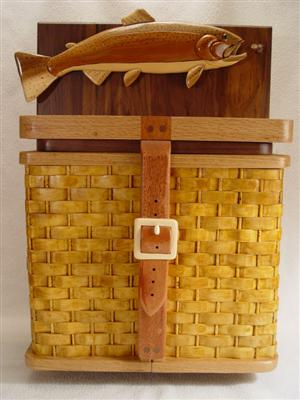
After learning of this event in late April 2005, I started brainstorming about the type of cabinet that would be enjoyable to make. My sketches ultimately progressed to this submission. I would be afraid to speculate on the time committed to develop this project. All I can say is “its an original design,” which is code for “I am lucky to still be married.” I do wish to thank my family for their support and I will now probably be able to creep back out of my garage workshop.
Initially, I was going to make a traditional “medicine cabinet” design, with an intarsia style door, with a fishing scene. However, as I started researching the goodies a fly fisherman uses to satisfy their habit, I really fell in love with the creel baskets. So I used that as the design basis for my submission. The other features grew up around that central theme.
This Fly Tying Cabinet is a “creel basket” with a rainbow trout about to engulf a lure. When you open the doors you will find storage for all the supplies and tools needed by a fisherman to hand tie their own flies. The rainbow trout is 17” X 6” and offset from the main walnut backer, which is 18” X 23”. The rainbow trout is a Robert Hlavacek, Sr. intarsia pattern. The fish is made from poplar, poplar heartwood, and cherry. The fins use a blend of poplar heartwood to emphasis some of the shading of the fish. The fish gained its spots by means of a wood-burning tool. A glass eye has been added for realism. This fish also has an appetite, as he approaches a lure that is held on a walnut dowel that has two rare earth magnets inside it. This was done by drilling and plugging the walnut dowel, after placing the magnets. This allows changing of the displayed lure, at the convenience of the fisherman.
|
| |
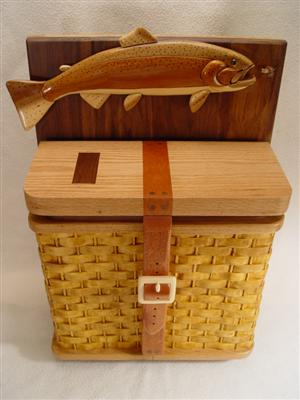
The top of the basket is oak ( 17” x 7 ¼”) with several inlayed areas. A hole to slip fish into the basket is represented by an inlayed walnut rectangle. Also the leather strap that is used to close the basket is represented by inlayed African mahogany, with walnut plugs acting as “rivets” to hold the strap in place. The strap proceeds down the front of the basket and feed in to an aspen intarsia buckle, that acts as the handle for the doors. The oak “top” is sitting on a piece of walnut (14 7/8” X 6 ¾”). These two piece are connected by three barrel hinges, when opened they reveal a fly tying bench. (The barrel hinges aren’t viewable in the images).
The doors of the basket are made of poplar that has multiple coats of a honey pine satin water based poly. Each door is made from two repeating patterns. The “A” pattern is topped by the “B” pattern which is then topped by the “A“ pattern again. There are 16 pieces stacked and edge glued in each panel. To accent the weave effect of the pattern, each of the vertical “reeds” was shaded using a wood-burning tool. The “rails and stiles” of each door is oak, joined by the pocket hole technique. Each door is 14” X 8 ¼”, and is 7 ¼” deep. The doors are kept shut by four pairs of rare earth magnets, drilled and doweled, in each side.
|
| |
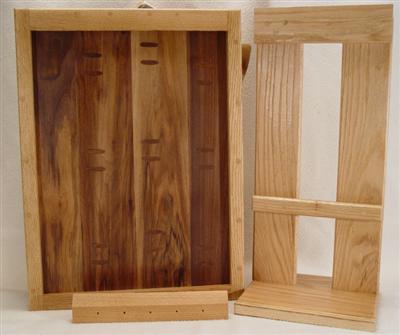
The back of the cabinet shows the doweled pocket holes used to join the walnut panels. The perimeter of the walnut backer is edged with oak. The upper piece is cut with a 45 degree face, allowing mounting to a wall. The “wall wedge” can be seen at the bottom of the image. I also made a stand to display the cabinet, and facilitate the ease of photographing the project.
|
| |
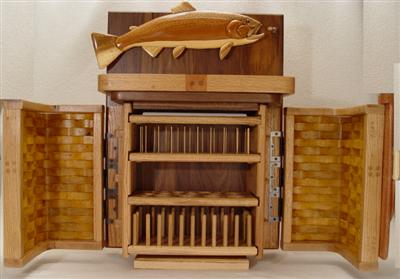
When the cabinet is opened 3 pairs of antique bronze non-mortised hinges are revealed. These are the only hardware items visible on the project (The barrel hinges are viewable when the “top” is taken off). Inside the cabinet four shelves are then accessible. Each is 11 ¾” X 5 ¼”, and is designed for a different function. Also, on the outboard sides of the shelving, there are three holders on each of the verticals. Allowing for storage of scissors, bobbins, pliers, and bodkins.
The shelves each have a specific function. The upper shelf is covered with ripple foam for the drying and stoarage of flies. The next shelf has 23 brass rods that can each hold two spools of thread, floss, or tinsel. These brass rods are near the perimeter of the shelf, allowing for center storage of feathers, furs, and skins. The next shelf has 17 relief holes for holding containers of beads, eyes, cements, and sealers. The bottom shelf is for storage of bulk items like vises, magnifiers, and stands. Each of the shelves have ½” round, clear plastic feet in each corner of its under surface. (When the doors are open, the base of the stand is visible, this will not be present when the cabinet is wall mounted).
|
| |
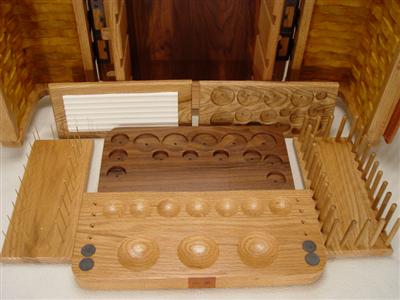
The “top” removes and unfolds to reveal a fly tying bench. The walnut section has 14 relief holes for containers. The oak section has four 1” magnets for holding hooks, eight counter sunk holes for holding tools, and three 2 ¾” and seven 1 ¾” cove hollows for placing bead, eyes, and other loose supplies.
The entire project is finished with multiple coats of a water based poly, this was to control the color and minimize any yellowing. The rainbow trout received a semi-gloss finish and everything else was satin.
|
| |
|
|